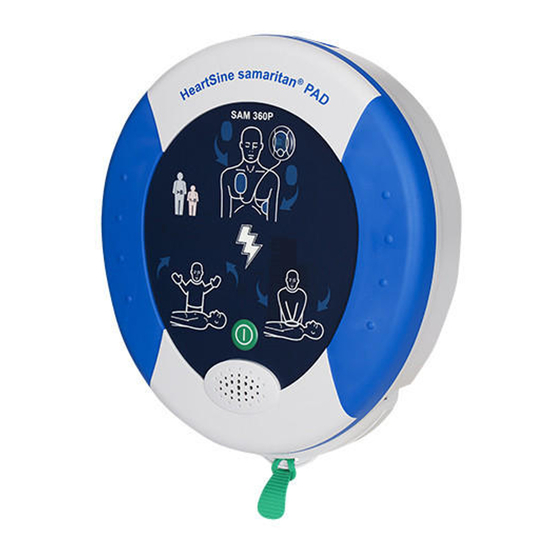
Summarization of Contents
Introduction and Regulatory Requirements
Introduction
Explains what the samaritan PAD is and its intended use for resuscitating victims of sudden cardiac arrest.
Regulatory Requirements
Details legal and regulatory requirements for defibrillators, including tracking and adverse event reporting.
Overview of the Samaritan PAD
Indications for Use
States the conditions and patient types for which the PAD is indicated, including age restrictions.
Samaritan PAD Controls
Describes the functions of each control on the samaritan PAD, such as the On/Off button and status indicator.
Samaritan PAD Symbols
Explains the various symbols used on the device and packaging to represent warnings and information.
Preparing the Samaritan PAD for Use
Quick List for PAD Preparation
A checklist to ensure the samaritan PAD is ready for immediate use in an emergency.
Understanding the Pad-Pak
Explains the components and importance of the Pad-Pak, which contains pads and battery.
Ensuring the Samaritan PAD is Working Correctly
Details how to verify the device is functioning properly, focusing on the status indicator.
Where to Place the Samaritan PAD
Provides guidance on selecting an accessible and visible location for the PAD.
Preparing the Patient for Therapy
Patient Checklist
Lists essential checks for preparing the patient, such as drying skin and removing metal objects.
Placing Pads on the Patient
Instructions on correctly attaching defibrillation pads to the patient's bare chest.
Using the Samaritan PAD
Quick Start Guide
A concise step-by-step guide for immediate use of the PAD in an emergency situation.
Useful Hints for PAD Use
Provides helpful tips and reassurance for users during the entire procedure.
Step-by-Step Instructions
Detailed instructions on operating the PAD, including protocol variations and CPR guidance.
Understanding Check Patient/CPR Mode
Explains the device's modes for post-shock assessment and CPR, based on configuration.
Post Use Procedure
Steps to follow after therapy is completed, including powering off and disposing of the Pad-Pak.
Understanding the Samaritan PAD
What is the Samaritan PAD?
Defines the samaritan PAD as a semi-automatic external defibrillator for SCA victims.
What does the Samaritan PAD do?
Outlines the functions: monitoring heart rhythm, advising therapy, and delivering shocks.
What is Heart Rhythm?
Explains normal sinus rhythm and life-threatening rhythms like Ventricular Fibrillation.
How does the Samaritan PAD work?
Details the operational process: monitoring ECG, analyzing rhythm, and delivering prompts.
What is Biphasic?
Explains the biphasic shock technology, which passes current in two directions for effective therapy.
Escalating Energy Protocol
Describes the escalating energy levels delivered during therapy, configurable to user needs.
Biphasic Waveform Specifications
Provides technical details on the biphasic waveform characteristics, adjusted for patient impedance.
How is Impedance Measured?
Explains the process and importance of impedance measurement for pad contact and waveform optimization.
Understanding the Samaritan PAD Interface
Understanding Visual Indicators
Explains the meaning of the device's visual indicators, including status and connection indicators.
Status Indicator
Details the function and interpretation of the device's status light for operational readiness.
Defibrillation Pads Connection Indicator
Explains the indicator that shows the status of defibrillation pad connection to the patient.
Shock Button Indicator
Describes the indicator that illuminates when the shock button is ready to deliver therapy.
Rescuer Action Indicators
Illustrates indicators guiding rescuer actions, such as 'Stand Clear' and 'OK to Touch'.
Audible Prompting
Explains the types of audible cues provided by the device, including indications and voice prompts.
Audible Indications
Specific audible cues that alert the user to device status, such as powering on.
Voice Prompting
Describes voice messages used for guidance, instructions, progress, and warnings during use.
Recording Samaritan PAD Usage Data
Recorded ECG Information
Details the ECG data recorded by the device before, during, and after therapy.
Events Log
Explains the log of events that occur during device use, including button presses and status changes.
Other Information Recorded
Lists additional data recorded by the device for reference, such as date, time, and serial number.
Maintaining the Samaritan PAD
Checking After Each Use
Procedure for checking the device after it has been used, including downloading data and installing a new Pad-Pak.
Monthly Checks to Perform
Regular checks to ensure the device and its supplies are in good working order and not expired.
Cleaning the Device
Instructions on how to properly clean the samaritan PAD using recommended solutions.
Storing the Device
Guidelines for storing the device safely and effectively in a clean, dry environment.
Battery Specifications
Information on battery life, capacity, and expiration date for the device.
Appendix
Samaritan PAD Technical Specifications
Technical details and specifications of the samaritan PAD, including physical and defibrillator parameters.
SCOPE Biphasic Waveform Specifications
Technical specifications of the SCOPE biphasic waveform, including voltage and duration parameters.
ECG Analysis Detection System Description
Describes the system for analyzing ECGs and detecting shockable arrhythmias like VF and VT.
ECG Arrhythmia Analysis Algorithm Performance
Presents performance data for the ECG arrhythmia analysis algorithm, including sensitivity and specificity.
SCOPE Biphasic Waveform Clinical Summary
Summarizes clinical trial results for the SCOPE biphasic waveform, comparing its effectiveness.

















Need help?
Do you have a question about the SAM 300 and is the answer not in the manual?
Questions and answers